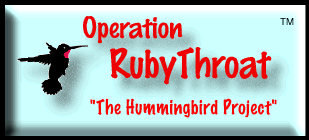 home: www.rubythroat.org |
|
home: www.rubythroat.org
|
The Ruby-throated Hummingbird (Archilochus colubris) is one of 339 hummingbird species, all of which occur ONLY in the Western Hemisphere. The Ruby-thraoted Hummingbird (abbreviated RTHU) was given its scientific name by Carolus Linnaeus (right), a Swedish botanist who was the first great modern taxonomist--a person who studies how living things are classified. The specimen first examined by Linnaeus was collected in South Carolina in 1758; he originally called it Trochilus colubris. Here are the taxonomic scheme and scientific nomenclature for the Ruby-throated Hummingbird: |
|
KINGDOM |
Animalia |
|
PHYLUM |
Chordata |
|
SUBPHYLUM |
Vertebrata |
|
CLASS |
Aves |
|
ORDER |
Apodiformes |
|
FAMILY |
Trochilidae |
|
GENUS |
Archilochus |
|
SPECIES (specific epithet) |
colubris |
|
The ordinal name, Apodiformes, means "no feet" because people once imagined that hummingbirds (and their relatives, the swifts) flew constantly and did not need feet for perching. Swifts and hummingbirds do have feet, of course, but they ARE weak and tiny. (You've probably seen a hummingbird perch on a feeder or a small branch--proof that they have feet.) The family name, Trochilidae, applies only to hummingbirds; the swifts are in the Apodidae. Trochilidae comes from the Greek word trochilos, meaning "a small bird." The genus name, Archilochus, comes from two Greek words meaning "first in importance" and "an ambush," while the origins and meaning of colubris are not clear. (Note that the genus and specific epithet are always italicized--or underlined if written by hand or on a typewriter.) One other North American hummingbird is closely related to the RTHU and is placed in the same genus: The Black-chinned Hummingbird (Archilochus alexandri). This species breed only in the western United States, but vagrant Black-chinneds have turned up in autumn or winter in the central and eastern U.S. Generally, in Spanish the RTHU is also known as colibrí rubí or mansoncito garganta de fuego or chupaflor rubi. (In Guatemala it's called colibrí gorjirrubi.) In French it is le Colibri à gorge rubis. The Lenape Indians of eastern Pennsylvania called ruby-throats Lelèmbëlis. In Pennsylavnia Dutch (German), RTHUs are called Shnaffag'le or Shnarrfag'le. Go next to Summer & Winter Distribution (range map) Up to Top of Page |
|
Make direct donations on-line through
Network for Good: |
 |
|
LIKE TO SHOP ON-LINE?
Donate a portion of your purchase price from 500+ top on-line stores via iGive: |
|
|
Use your PayPal account
to make direct donations: |
|
|
|
Share Your Hummingbird Experiences Through "Hummingbird Hobnob" |
 |
Operation |
|
|